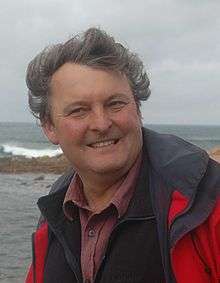Mark Horton (archaeologist)

Mark Chatwin Horton, FSA (born 15 February 1956) is a British maritime and historical archaeologist, television presenter and writer.
Academic career
Horton attended Cambridge University, graduating and receiving a doctorate. He is Professor in Archaeology at the University of Bristol.[1] One of his former students is Sam Willis.
He has conducted excavations in Zanzibar, Egypt, the Caribbean, North America, Central America and France, as well as sites in Britain. His chief publications are on the Swahili site of Shanga, Kenya[2] between 1980 and 1986 and more recently sites on the islands of Zanzibar and Pemba, notably Tumbatu, Ras Mkumbuu, Mtambwe Mkuu and Chwaka.
He also has a strong interest in maritime archaeology and is the Programme Director of the MA Maritime Archaeology and History at Bristol University.[3]
His other excavations include the Scottish Darien scheme (1698–1700) in Panama; the Cistercian Abbey of Grosbot (Charente, France); the Bishop's Palace at Wells; a medieval farmstead at Carscliffe, Somerset; Fishmongers Cave, Alveston (South Gloucestershire) and he is currently working at Berkeley Castle (Gloucestershire). In 2008-11 he undertook survey and excavation work in the Kherlen Valley in Mongolia. Between 2011-13, he has worked with the Sealinks Project, undertaking excavations on Pemba, Zanzibar, Mafia, Anjouan, Sri Lanka and Madagascar.[4]
He also has an abiding interest in Isambard Kingdom Brunel and directed the digitisation of the engineer's sketch books and letters at Bristol University library, which project was grant-aided by the Arts and Humanities Research Council in 2003,[5]
He was elected a Fellow of the Society of Antiquaries of London on 7 May 1992.[6]
TV career
Mark Horton's first television appearances sprang from his academic work in East Africa. He contributed to a programme by Time Life Television Lost Civilisations – Africa in 1996 and to a Channel 4 television programme on the Atlantic slave trade in 1998.
He was closely involved in the inception of the long-running Channel 4 television series Time Team and the first episode was filmed in his home town of Much Wenlock, Shropshire in 1994. He has appeared on several subsequent programmes including Hylton Castle, Sunderland, in 1995 and Aston Eyre, Shropshire in 1998.[7] In 2000 he acted as tiles specialist on Time Team Live.[8] Having invited Time Team to investigate the bones found by cavers in a cave in the village of Alveston, Gloucestershire, he appeared in the programme on this site shown in 2001.[9] In 2008, further work on the site was included in a National Geographic / Channel Five documentary, Julius Caesar and the Druids.[10]
He was a co-presenter on two series of the BBC Two production, Time Flyers 2002 – 2003. In 2004 he presented BBC Scotland's programme Darien: Disaster in Paradise, which was highly commended in the archaeological film category at that year's British Archaeological Awards. From 2005 Horton is one of the team of presenters on the programme Coast, exploring the coastline of Britain.[11][12] He also presents occasional pieces for BBC1 Inside Out, West and South West Regions.[13] He was the archaeological consultant on the TV drama Bonekickers, shown on BBC One in 2008.
Interests
He is a keen sailor and enjoys dinghy-sailing on the River Severn and restoring his historic 26-foot (7.9 m) yacht, Mignonette, a Lone Gull design of Maurice Griffiths and built in 1946-7.[14]
Books
- 1996. Shanga: The Archaeology of a Muslim Trading Community on the Coast of East Africa. British Institute in Eastern Africa, Monograph Series 14. (with Helen W. Brown and Nina Mudida).
- 2001. The Swahili. Oxford: Blackwell (with John Middleton).
References
- ↑ Bristol University – Department of Archaeology and Anthropology – Mark Horton. Bristol.ac.uk. Retrieved on 2011-05-01.
- ↑ Mark Horton, Shanga, the archaeology of a Muslim trading community on the coast of East Africa, British Institute in Eastern Africa (1986)
- ↑ Bristol University staff biography.
- ↑
- ↑ Award 30 April 2003 of £82810 by the Arts and Humanities Research Council.
- ↑ Society of Antiquaries of London list of Fellows
- ↑ Internet Movie Database
- ↑ Channel 4: Time Team Live 2000 Tyler Hill Diary
- ↑ Channel 4: Time Team: The Bone Cave, Alveston, Gloucestershire 1 March 2001
- ↑ http://www.imdb.com/title/tt1280386/
- ↑ Bristol University staff biography
- ↑ British Archaeological Awards 2004
- ↑ One Programmes – Inside Out West. BBC (2011-03-07). Retrieved on 2011-05-01.
- ↑ Classic Boat March 2009, no 249, p. 51